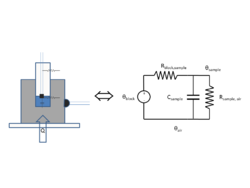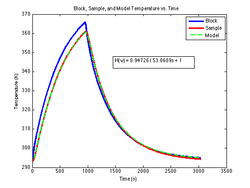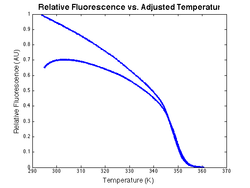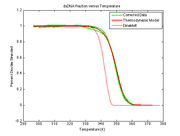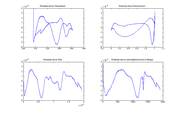Difference between revisions of "DNA Melting: Model function and parameter estimation by nonlinear regression"
(→Evaluating the model) |
|||
| Line 14: | Line 14: | ||
The goal is to write a model for <math>V_f</math> that takes these effects into account and use nonlinear regression to estimate the parameters. | The goal is to write a model for <math>V_f</math> that takes these effects into account and use nonlinear regression to estimate the parameters. | ||
| + | |||
| + | ==Sample temperature model== | ||
| + | [[Image:Heating block and sample.png|thumb|250px|right]] | ||
| + | [[Image:Circuit model of heating block and sample.png|thumb|250px|right]] | ||
| + | [[Image:Corrected and measured temperature.png|thumb|250px|right]] | ||
| + | [[Image:DNA melting data corrected for temperature lag.png|thumb|250px|right]] | ||
| + | |||
| + | ===Assumptions=== | ||
| + | * The RTD measures the temperature of the metal heating block, which has a much larger heat capacity than the sample. | ||
| + | * The cuvette is modeled as a thermal resistance; its heat capacity is neglected. | ||
| + | * The sample has a constant heat capacity with uniform temperature throughout. | ||
| + | * Heat escaping from the sample is modeled by a thermal resistance between the sample and room temperature | ||
| + | |||
| + | <center><math>\frac{\hat{\theta}_{sample}(\omega)} {\hat{\theta}_{block}(\omega)}=\frac{K_{thermal}}{\tau_{thermal} s + 1}</math></center> | ||
==Photobleaching== | ==Photobleaching== | ||
Revision as of 14:46, 16 November 2012
This subject matter will be explained in lecture, in tutorials, and in the lab.
Overview
In addition to the dsDNA concentration, the fluorescence voltage output, $ V_f $, depends of several factors, including:
- dynamics of the temperature cycling system
- $ \Delta H^{\circ} $ and $ \Delta S^{\circ} $
- thermal quenching of the fluorophore
- photobleaching
- responsivity and offset of the instrument
The goal is to write a model for $ V_f $ that takes these effects into account and use nonlinear regression to estimate the parameters.
Sample temperature model
Assumptions
- The RTD measures the temperature of the metal heating block, which has a much larger heat capacity than the sample.
- The cuvette is modeled as a thermal resistance; its heat capacity is neglected.
- The sample has a constant heat capacity with uniform temperature throughout.
- Heat escaping from the sample is modeled by a thermal resistance between the sample and room temperature
Photobleaching
Excited fluorescent dye molecules may react chemically with compounds in their environment and permanently lose their ability to fluoresce — a phenomenon called photobleaching. LED and ambient light illuminate the SYBR Green dye for 15 or more minutes over the course of a single melting and annealing cycle, which results in measurable photobleaching. Bleaching can be diminished by lowering the illumination; however, the signal is also proportionally reduced. Photobleaching can also be corrected by a mathematical model.
Assumptions
Photobleaching is a complicated phenomenon. The model proposed here adheres to Dr. George E. P. Box's excellent advice on modeling. Some of the assumptions are more suspect than others.
Which assumptions are probably significant sources of systematic error?
- The dye is divided into two populations, bleached and unbleached, with concentrations S and S
- The initial dye concentration is S + S
- Only dye molecules bound to dsDNA may be excited.
- Only excited fluorophore molecules bleach
- An excited fluorophore will either bleach with probability $ p $ or return to the ground state with probability $ 1-p $.
- The constant $ 1-p $ encompasses all of the mechanisms by which the fluorophore returns to the ground state unbleached, including fluorescence, phosphorescence, and non-radiative relaxation.
- Bleaching is irreversible.
- The number of molecules in the excited state is proportional to fluorescence.
- Bleached and unbleached molecules bind to dsDNA with the same affinity.
Model
Under these assumptions, the bleaching rate is proportional to fluorescence.
$ K_{bleaching} $ encompasses several constants, including $ p $, illumination intensity, optical gain of the instrument, and lock-in amplifier gain.
Setting the initial dye concentration to 1, the fraction of unbleached SYBR Green can be calculated by integrating:

